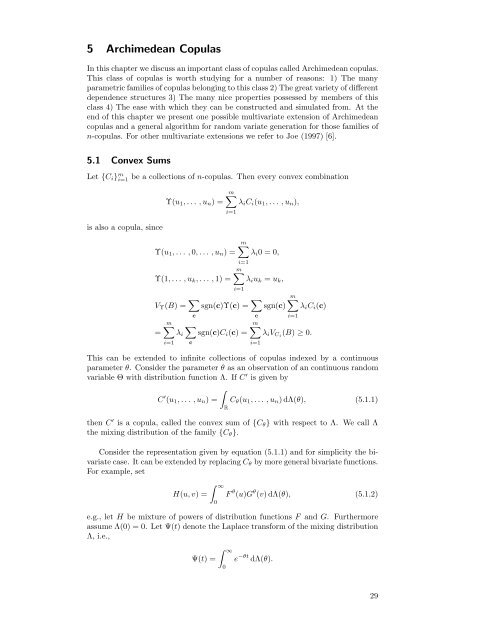Modelling Dependence with Copulas - IFOR
Modelling Dependence with Copulas - IFOR
Modelling Dependence with Copulas - IFOR
Create successful ePaper yourself
Turn your PDF publications into a flip-book with our unique Google optimized e-Paper software.
5 Archimedean <strong>Copulas</strong><br />
In this chapter we discuss an important class of copulas called Archimedean copulas.<br />
This class of copulas is worth studying for a number of reasons: 1) The many<br />
parametric families of copulas belonging to this class 2) The great variety of different<br />
dependence structures 3) The many nice properties possessed by members of this<br />
class 4) The ease <strong>with</strong> which they can be constructed and simulated from. At the<br />
end of this chapter we present one possible multivariate extension of Archimedean<br />
copulas and a general algorithm for random variate generation for those families of<br />
n-copulas. For other multivariate extensions we refer to Joe (1997) [6].<br />
5.1 Convex Sums<br />
Let {C i } m i=1 be a collections of n-copulas. Then every convex combination<br />
is also a copula, since<br />
Υ(u 1 ,... ,u n )=<br />
m∑<br />
λ i C i (u 1 ,... ,u n ),<br />
i=1<br />
Υ(u 1 ,... ,0,... ,u n )=<br />
Υ(1,... ,u k ,... ,1) =<br />
m∑<br />
λ i 0=0,<br />
i=1<br />
m∑<br />
λ i u k = u k ,<br />
i=1<br />
V Υ (B) = ∑ sgn(c)Υ(c) = ∑ m∑<br />
sgn(c) λ i C i (c)<br />
c<br />
c<br />
i=1<br />
m∑ ∑<br />
m∑<br />
= λ i sgn(c)C i (c) = λ i V Ci (B) ≥ 0.<br />
i=1<br />
c<br />
This can be extended to infinite collections of copulas indexed by a continuous<br />
parameter θ. Consider the parameter θ as an observation of an continuous random<br />
variable Θ <strong>with</strong> distribution function Λ. If C ′ is given by<br />
∫<br />
C ′ (u 1 ,... ,u n )= C θ (u 1 ,... ,u n )dΛ(θ), (5.1.1)<br />
R<br />
then C ′ is a copula, called the convex sum of {C θ } <strong>with</strong> respect to Λ. We call Λ<br />
the mixing distribution of the family {C θ }.<br />
Consider the representation given by equation (5.1.1) and for simplicity the bivariate<br />
case. It can be extended by replacing C θ by more general bivariate functions.<br />
For example, set<br />
H(u, v) =<br />
∫ ∞<br />
0<br />
i=1<br />
F θ (u)G θ (v)dΛ(θ), (5.1.2)<br />
e.g., let H be mixture of powers of distribution functions F and G. Furthermore<br />
assume Λ(0) = 0. Let Ψ(t) denote the Laplace transform of the mixing distribution<br />
Λ, i.e.,<br />
Ψ(t) =<br />
∫ ∞<br />
0<br />
e −θt dΛ(θ).<br />
29
















